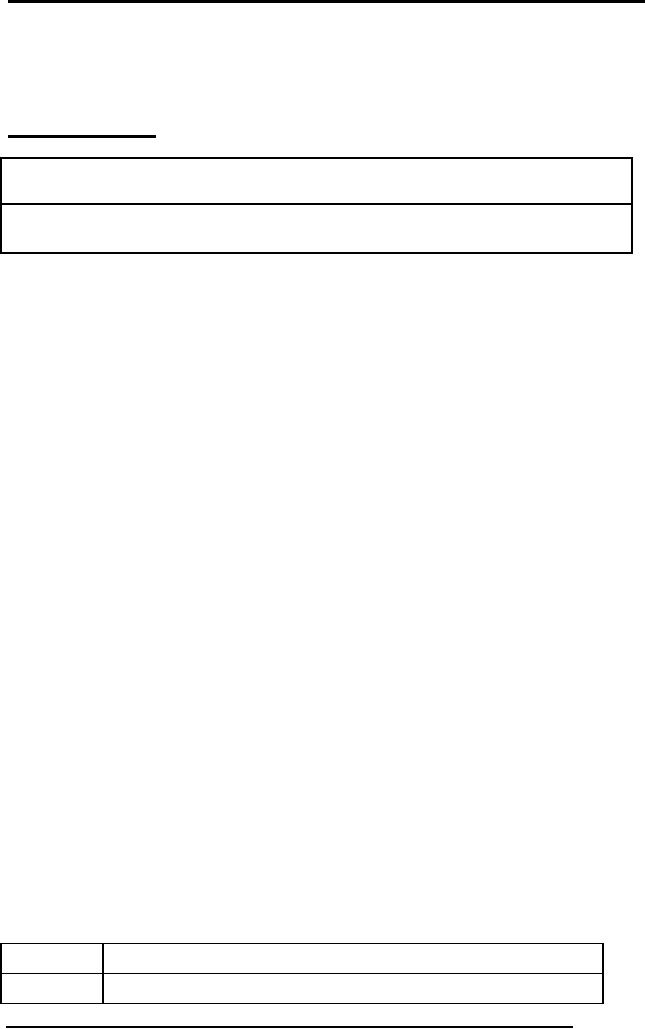 |
Alter Table Statement |
| << Categories of SQL Commands, |
| Select Statement, Attribute Allias >> |

Database
Management System
(CS403)
VU
Lecture No.
27
Reading
Material
"Database
Management Systems", 2nd edition, Raghu Ramakrishnan,
Johannes Gehrke,
McGraw-Hill
"Teach
Yourself SQL in 21 Days", Second
Edition Que Series.
Overview of
Lecture
Data
Manipulation Language
In the
previous lecture we were
studying DDL in which we studied
the CREATE
command
along with different
examples. We also saw different
constraints of create
command.
In this lecture we will study
the ALTER and other
SQL commands with
examples.
Alter
Table Statement
The
purpose of ALTER statement is to make
changes in the definition of a
table
already
created through Create statement. It can
add, and drop the
attributes or
constraints,
activate or deactivate constraints. It
modifies the design of an
existing
table.
The format of this command
is as under:
Syntax
ALTER
TABLE table {
ADD
[COLUMN] column type
[(size)] [DEFAULT default]
|
ALTER
[COLUMN] column type [(size)]
[DEFAULT default] |
ALTER
[COLUMN] column SET DEFAULT
default |
DROP
[COLUMN] column |
RENAME
[COLUMN] column TO
columnNew
}
The
ALTER TABLE statement has these
parts:
Part
Description
Table
The
name of the table to be
altered.
206

Database
Management System
(CS403)
VU
Column
The
name of the column to be
altered or added to or deleted from
table.
ColumnNew
The new name of the
altered column
Type
The data
type of column.
The
size of the altered column
in characters or bytes for
text or binary
Size
columns.
An
expression defining the new
default value of the altered
column.
Default
Can
contain literal values, and
functions of these
values
Using
the ALTER TABLE statement, we can
alter an existing table in
several
ways. We
can:
Use ADD
COLUMN to add a new column to
the table. Specify the name,
data
�
type, an
optional size, and an optional
default value of the
column.
Use
ALTER COLUMN to alter type,
size or default value of an
existing
�
column.
Use
DROP COLUMN to delete a column.
Specify only the name of
the
�
column.
Use
RENAME COLUMN to rename an existing column. We
cannot add,
�
delete or
modify more than one
column at a time.We will now
see an example
of alter
command
ALTER
TABLE Student
add
constraint fk_st_pr
foreign
key (prName) references
Program
(prName)
This is a
simple example, in which we
have incorporated a constraint
and the names
are
meaningful, so that if in the
future we have to refer
them, we can do so. We
will
now
see an example of removing or
changing attribute.
ALTER
TABLE student
ALTER
COLUMN stFName char (20)
ALTER
TABLE student
Drop
column curSem
ALTER
TABLE student
Drop
constraint ck_st_pr
Now in
these examples either an
attribute is deleted or altered by
using the keywords
of Drop
and Alter. We will now see
an example in which few or
all rows will be
removed,
or whole table is required to be
removed. The TRUNCATE is
used to delete
all
the rows of any table
but rows would exist.
The DELETE is used to delete
one or
many
records. If we want to remove all records
we must use TRUNCATE. Next is
the
DROP
table command, which is used
to drop the complete table
from the database.
TRUNCATE
TABLE table_name
Truncate
table class
207

Database
Management System
(CS403)
VU
Delete
can also be used
DROP
TABLE table_name
Data
Manipulation Language
The
non-procedural nature of SQL is
one of the principle characteristics of
all 4GLs -
Fourth
Generation Languages - and contrasts
with 3GLs (eg, C, Pascal,
Modula-2,
COBOL,
etc) in which the user has
to give particular attention to
how data is to be
accessed
in terms of storage method,
primary/secondary indices,
end-of-file
conditions,
error conditions (eg, Record
NOT Found), and so on.
The Data
Manipulation
Language (DML) is used to retrieve,
insert and modify
database
information.
Data Manipulation is retrieval,
insertion, deletion and
modification of
information
from the database SQL is a
non-procedural language that
is, it allows the
user to
concentrate on specifying what data is
required rather than
concentrating on
the
how to get it. There
are two types of DML.First
is procedural in which: the
user
specifies
what data is needed and how to
get it. Second is nonprocedural in
which the
user
only specifies what data is needed.
The DML component of SQL comprises
of
following
basic statements:
Insert
To
add new rows to
tables.
Select
To
retrieve rows from
tables
Update
To
modify the rows of
tables
Insert
The
INSERT command in SQL is
used to add records to an existing
table. We will
now
see the format of insert
command as under:
INSERT
[INTO] table
{[ ( column_list
)
]
{
VALUES
( { DEFAULT
| NULL | expression } [ ,...n] )
}
}
| DEFAULT
VALUES
The basic
format of the INSERT...VALUES statement adds a record to a
table using the
columns
you give it and the
corresponding values you
instruct it to add. You
must
follow
three rules when inserting
data into a table with the
INSERT...VALUES
statement:
The
values used must be the same
data type as the fields they
are being added
to.
The
data's size must be within
the column's size. For
instance, you cannot add an
80-
character
string to a 40-character
column.
The
data's location in the VALUES
list must
correspond to the location in
the column
list of
the column it is being added
to. (That is, the
first value must be entered
into the
first
column, the second value
into the second column,
and so on.)
The
rules mentioned above must be
followed. We will see the
examples of the
insert
statement in
the coming lectures.
Summary
SQL
provides three statements
that can be used to
manipulate data within a
database.
The
INSERT
statement has
two variations. The INSERT...VALUES statement inserts a
set
of values
into one record. The
INSERT...SELECT
statement is used
in combination with
a SELECT statement to insert
multiple records into a table
based on the contents of
one
or more
tables. The SELECT statement can join multiple
tables, and the results of
this
208

Database
Management System
(CS403)
VU
join
can be added to another table.
The UPDATE statement changes the values
of one
or more
columns based on some
condition. This updated
value can also be the
result
of an
expression or calculation.
The
DELETE
statement is the
simplest of the three
statements. It deletes all rows
from
a table
based on the result of an
optional WHERE clause. If the WHERE clause is
omitted,
all records from the table
are deleted. Modern database
systems supply
various
tools for data manipulation.
Some of these tools enable
developers to import
or export
data from foreign sources.
This feature is particularly
useful when a
database
is upsized or downsized to a different
system. Microsoft Access,
Microsoft
and
Sybase SQL Server, and
Personal Oracle7 include many
options that support
the
migration
of data between
systems.
Exercise:
Try
inserting values with
incorrect data types into a
table. Note the errors and
then
insert
values with correct data
types into the same
table.
209
Table of Contents:
- Introduction to Databases and Traditional File Processing Systems
- Advantages, Cost, Importance, Levels, Users of Database Systems
- Database Architecture: Level, Schema, Model, Conceptual or Logical View:
- Internal or Physical View of Schema, Data Independence, Funct ions of DBMS
- Database Development Process, Tools, Data Flow Diagrams, Types of DFD
- Data Flow Diagram, Data Dictionary, Database Design, Data Model
- Entity-Relationship Data Model, Classification of entity types, Attributes
- Attributes, The Keys
- Relationships:Types of Relationships in databases
- Dependencies, Enhancements in E-R Data Model. Super-type and Subtypes
- Inheritance Is, Super types and Subtypes, Constraints, Completeness Constraint, Disjointness Constraint, Subtype Discriminator
- Steps in the Study of system
- Conceptual, Logical Database Design, Relationships and Cardinalities in between Entities
- Relational Data Model, Mathematical Relations, Database Relations
- Database and Math Relations, Degree of a Relation
- Mapping Relationships, Binary, Unary Relationship, Data Manipulation Languages, Relational Algebra
- The Project Operator
- Types of Joins: Theta Join, Equi–Join, Natural Join, Outer Join, Semi Join
- Functional Dependency, Inference Rules, Normal Forms
- Second, Third Normal Form, Boyce - Codd Normal Form, Higher Normal Forms
- Normalization Summary, Example, Physical Database Design
- Physical Database Design: DESIGNING FIELDS, CODING AND COMPRESSION TECHNIQUES
- Physical Record and De-normalization, Partitioning
- Vertical Partitioning, Replication, MS SQL Server
- Rules of SQL Format, Data Types in SQL Server
- Categories of SQL Commands,
- Alter Table Statement
- Select Statement, Attribute Allias
- Data Manipulation Language
- ORDER BY Clause, Functions in SQL, GROUP BY Clause, HAVING Clause, Cartesian Product
- Inner Join, Outer Join, Semi Join, Self Join, Subquery,
- Application Programs, User Interface, Forms, Tips for User Friendly Interface
- Designing Input Form, Arranging Form, Adding Command Buttons
- Data Storage Concepts, Physical Storage Media, Memory Hierarchy
- File Organizations: Hashing Algorithm, Collision Handling
- Hashing, Hash Functions, Hashed Access Characteristics, Mapping functions, Open addressing
- Index Classification
- Ordered, Dense, Sparse, Multi-Level Indices, Clustered, Non-clustered Indexes
- Views, Data Independence, Security, Vertical and Horizontal Subset of a Table
- Materialized View, Simple Views, Complex View, Dynamic Views
- Updating Multiple Tables, Transaction Management
- Transactions and Schedules, Concurrent Execution, Serializability, Lock-Based Concurrency Control, Deadlocks
- Incremental Log with Deferred, Immediate Updates, Concurrency Control
- Serial Execution, Serializability, Locking, Inconsistent Analysis
- Locking Idea, DeadLock Handling, Deadlock Resolution, Timestamping rules